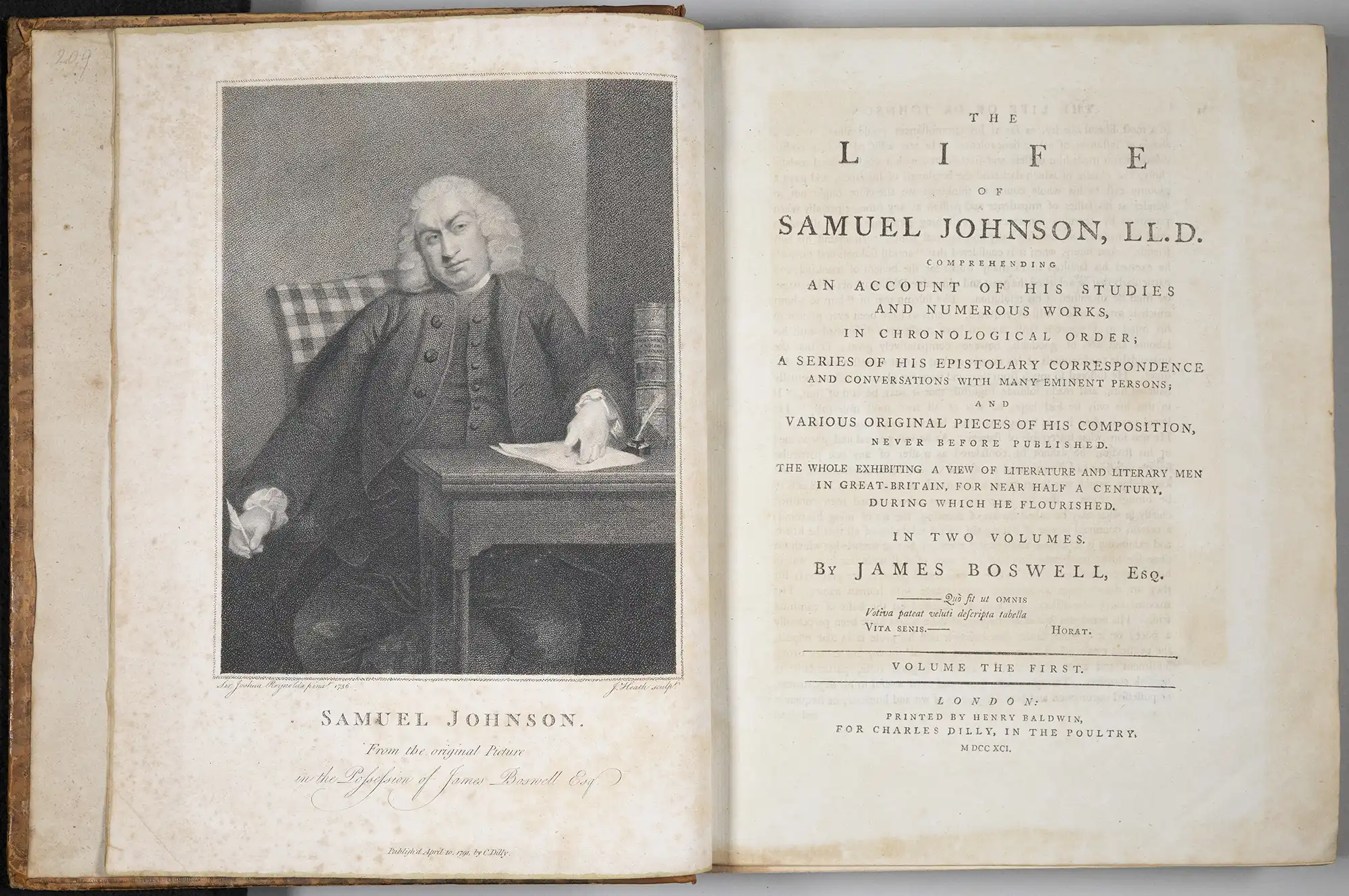Case 12
- Samuel Johnson 2

James Boswell. The life of Samuel Johnson, LL. D. London: Printed by Henry Baldwin, for Charles Dilly, 1791. Two volumes, Vol 1 displayed.
Reed’s primary literary interest was Dickens, but he was also drawn to Samuel Johnson (1709-1784) for his literary merit, personality, and no doubt his piety. He began collecting Johnsoniana about the end of the First World War, gathering not just books, but a wealth of manuscript material, chiefly autograph letters.
The collection includes several early editions of James Boswell’s Life of Samuel Johnson, including a first edition, displayed here. When Boswell (1740–1795) met Johnson on 16 May 1763, Johnson was fifty-four and an established literary lion; Boswell, twenty-two, was a young Scotsman on the make in London, who was to pursue a career as a lawyer in Edinburgh and a writer in London. He conceived the idea of writing Johnson’s life very early in their friendship and collected information accordingly. “Boswell’s Life of Johnson” has – almost from the day of its publication – been a far more famous book than any of the books of its subject and has passed through hundreds of editions.

James Boswell. The life of Samuel Johnson, LL. D. London: Printed by Henry Baldwin, for Charles Dilly, 1791. Two volumes, Vol 1 displayed.
Open image in new window
![Samuel Johnson. The plays of William Shakespeare. London: Printed for J. and R. Tonson [etc.], 1765. Eight volumes; Vol. 1 displayed.](https://www.reedgallery.co.nz/__data/assets/image/0020/1263341/12b.webp)
Samuel Johnson. The plays of William Shakespeare. London: Printed for J. and R. Tonson [etc.], 1765. Eight volumes; Vol. 1 displayed.
Johnson issued the proposals for an edition of Shakespeare, together with a sample of his remarks on Macbeth, in 1745, but the edition did not proceed due to copyright problems. Ten years later, backed by a consortium of commissioning booksellers and with his Dictionary published, Johnson undertook the work seriously, but after a good start the work slowed, and the 8 vols. did not appear until 1765.
Johnson’s work has an important place in the tradition of scholarly editing of Shakespeare; he makes much use of the previous editors, adjudicating between their readings and interpretations. His Preface is a major critical work and considered by some scholars to be his best piece of critical writing.
A.H. Reed acquired the Library’s first edition of Johnson’s Shakespeare in 1964 from Maggs Bros of London.
![Samuel Johnson. The plays of William Shakespeare. London: Printed for J. and R. Tonson [etc.], 1765. Eight volumes; Vol. 1 displayed.](https://www.reedgallery.co.nz/__data/assets/image/0020/1263341/12b.webp)
Samuel Johnson. The plays of William Shakespeare. London: Printed for J. and R. Tonson [etc.], 1765. Eight volumes; Vol. 1 displayed.
Open image in new window

Joseph Addison and Richard Steele (editors). The spectator. London: Printed for J. and R. Tonson and S. Draper, 1749. Eight volumes; Vol. 1 displayed.
In 1929, A.H. Reed purchased for 26 shillings from a London antiquarian bookseller an eight-volume 1749 set of The spectator “with contemporary signature on title Vol. 1 Sam Johnson.” Reed wrote in 1955 that “anyone who is familiar with Dr Johnson’s handwriting and signature will have no hesitation in recognising his autograph, not in one but in two volumes.”
In seeking scholarly confirmation, Reed sent a photo-stat of the title page to the Johnsonian scholar J.D. Fleeman in 1968. Fleeman (1932-1994) replied with ‘delight and enthusiasm’ at Reed’s ownership of Johnson’s copy of The spectator, confirmed its authenticity, and later listed the book in his A preliminary handlist of copies of books associated with Dr. Samuel Johnson (Oxford, 1984).
Boswell records in his famed biography that on the evening of 3 April 1773 Johnson read aloud passages from The spectator to prove the point of an argument. Reed later wrote: “[This] is the set, I like to think, from which Johnson read aloud to Boswell”.

Joseph Addison and Richard Steele (editors). The spectator. London: Printed for J. and R. Tonson and S. Draper, 1749. Eight volumes; Vol. 1 displayed.
Open image in new window

![Samuel Johnson. The plays of William Shakespeare. London: Printed for J. and R. Tonson [etc.], 1765. Eight volumes; Vol. 1 displayed.](https://www.reedgallery.co.nz/__data/assets/image/0020/1263341/12b.webp)
